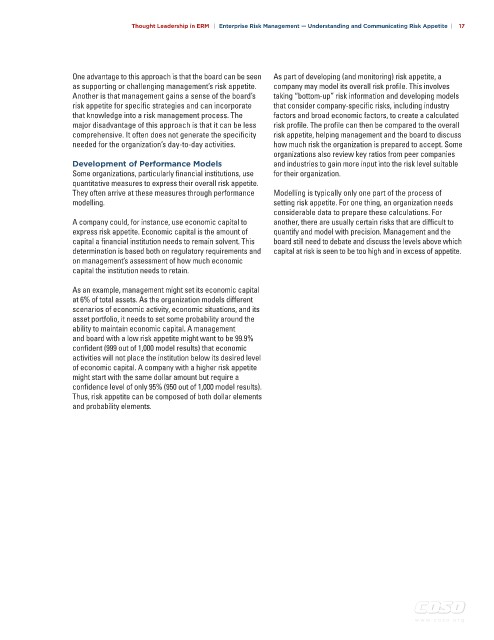Page 706 - COSO Guidance
P. 706
Thought Leadership in ERM | Enterprise Risk Management — Understanding and Communicating Risk Appetite | 17
One advantage to this approach is that the board can be seen As part of developing (and monitoring) risk appetite, a
as supporting or challenging management’s risk appetite. company may model its overall risk profile. This involves
Another is that management gains a sense of the board’s taking “bottom-up” risk information and developing models
risk appetite for specific strategies and can incorporate that consider company-specific risks, including industry
that knowledge into a risk management process. The factors and broad economic factors, to create a calculated
major disadvantage of this approach is that it can be less risk profile. The profile can then be compared to the overall
comprehensive. It often does not generate the specificity risk appetite, helping management and the board to discuss
needed for the organization’s day-to-day activities. how much risk the organization is prepared to accept. Some
organizations also review key ratios from peer companies
Development of performance Models and industries to gain more input into the risk level suitable
Some organizations, particularly financial institutions, use for their organization.
quantitative measures to express their overall risk appetite.
They often arrive at these measures through performance Modelling is typically only one part of the process of
modelling. setting risk appetite. For one thing, an organization needs
considerable data to prepare these calculations. For
A company could, for instance, use economic capital to another, there are usually certain risks that are difficult to
express risk appetite. Economic capital is the amount of quantify and model with precision. Management and the
capital a financial institution needs to remain solvent. This board still need to debate and discuss the levels above which
determination is based both on regulatory requirements and capital at risk is seen to be too high and in excess of appetite.
on management’s assessment of how much economic
capital the institution needs to retain.
As an example, management might set its economic capital
at 6% of total assets. As the organization models different
scenarios of economic activity, economic situations, and its
asset portfolio, it needs to set some probability around the
ability to maintain economic capital. A management
and board with a low risk appetite might want to be 99.9%
confident (999 out of 1,000 model results) that economic
activities will not place the institution below its desired level
of economic capital. A company with a higher risk appetite
might start with the same dollar amount but require a
confidence level of only 95% (950 out of 1,000 model results).
Thus, risk appetite can be composed of both dollar elements
and probability elements.
w w w . c o s o . o r g

